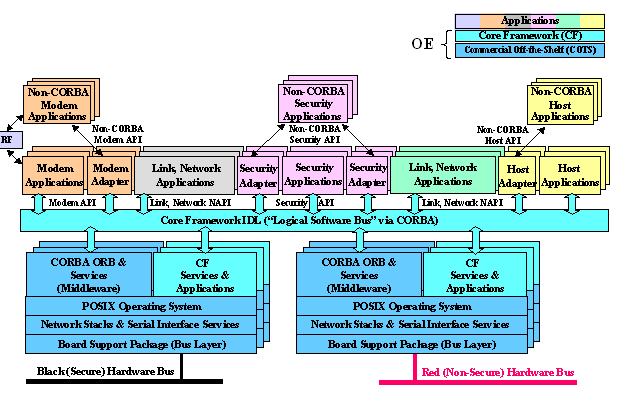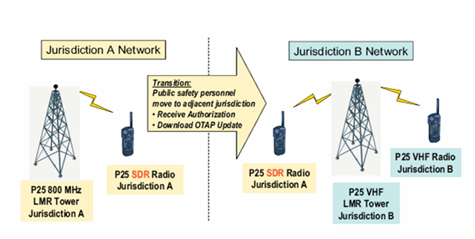In the last Tech Topic we showed that by configuring a flexible radio architecture to meet the transmission characteristics of any desired radio network, interoperability among an entire class of new radios as well as existing radios could be achieved. This was the foundation of the concept of software radio where most of the functionality of a radio is accomplished by software running on either general purpose processors or on digital signal processors. Once information from a source is converted to a digital representation, then all of the normal radio functions can be done via software-driven automated functions. By changing the software, a new radio can be configured dependent on a software definition of the operating characteristics of the radio. Hence “software radios” became “software-defined radios,” with promise to provide for redundancy and a robust opportunity for system design and accessibility.
The promise of software defined radios for rapidly changing the operating characteristics of radios suggests further an exciting new method to create opportunities and means for interoperability among and between any number of different radio systems – particularly public safety radio systems such as conventional land mobile radio (LMR), trunked-radio systems, Project-25 compliant radio systems 1, TETRA-compliant systems 2 , commercial mobile cellular systems, or other public safety specific radio systems.
As suggested in the previous Tech Topic, the flexibility and modularity of software defined radio systems result from the software communications architecture (SCA) that is the fundamental construction of the software defined radio. An earlier and more detailed version of the SCA is depicted by the diagram below 3. This diagram shows the application layer residing on top of the CORBA 4 middleware layer that in turn rests on the operating system of the radio hardware.

In this version, it is easier to identify the various application components of the radio. For example, the modem application provides modulator/demodulator functionality between the radio frequency antenna elements and the network level applications that include the message (information) handling requirements. Similarly, the “host” applications would include such applications as the conversion of information from the user in analog form to a digital representation analog-to-digital (ADC) and vice versa; digital-to-analog conversion (DAC). The promise for public safety radio lies in the ability of software defined radios to reconfigure the operating characteristics rapidly simply by changing the inherent software and instantiating a different software package to provide the desired operating requirements in terms of over the air characteristics as well as information/networking requirements such as coding.
The agility of these radios to adapt to new operating parameters is the real strength of the SDR in a public safety application. It should also be recognized that the ability to rapidly reconfigure and adjust to new operating conditions, parameters, and networks leads to interoperability on a new and pervasive basis. Even the ability to do Over-the-Air-Programming (OTAP) becomes an extremely valuable capability for software defined radios in a public safety scenario. 5 As the diagram below suggests, the ability for radios to be “reprogrammed” via OTAP to accommodate new operating parameters is extremely valuable.

The National Institute of Justice (NIJ) recognized the potential of SDRs and suggested several Key Points for Public Safety Communications Interoperability. 6 The NIJ has also addressed the technology side of SDR development in its “Public Safety Reconfigurable SDR Roadmap.” This roadmap addresses a number of the technical constraints/issues that are critical to SDR development. Although the NIJ report alludes to these issues, three stand out as the primary design issues that must be overcome.
The first key issue is simply the ability to convert from analog to digital (A-D) signals. From the host user’s perspective, this is common practice now over any number of devices (and has been for years) such as mobile personal devices and is not a problem of particular concern.
The conversion of radio frequency-level signals is entirely another matter and is the key to accomplishing a completely digital software radio. If A-D conversion can take place immediately at the antenna, then all functions within the radio can be done digitally (i.e. in software). The Sampling Theorem from Harry Nyquist and Claude Shannon dictates that signals must be sampled at a rate at least twice the highest frequency of the signal being sampled in order to be able to accurately and faithfully reproduce the original signal from its sampled values. 7 For example, this means that a radio frequency signal at around 10 MHz must be sampled at a rate of at least 20 Mega-samples/second, and more likely in practice at a rate of about 2.5 times – or 25 Mega-samples/sec. Coincidently, each sample value must be converted to a digital representation which requires the delineation of the number of bits required to represent each sample value – a design criterion that reflects the accuracy of the sample values. Typically, this has been on the order of 8 bits per sample depending on the desired fidelity. So for our example, a 10 MHz signal would be sampled at 25 Mega-samples/sec and each sample coded to 8 bits/sample, so that the analog to digital conversion would result in a bit rate of 200 Mbps (25 Mega-samples/sec times 8 bits/sample). The timing and synchronization required to handle 200 Mbps throughout the radio system is a key factor in determining the performance of the radio and is a non-trivial design problem.
The example above for a 10 MHz RF signal is simplistic. The lowest public safety band is the 30-40 MHz, or low VHF band. Other radios would have to operate in the 152-162 MHz VHF band, the 406-512 MHz UHF band, or perhaps the 700 MHz or even 800 MHz bands. In these cases, much higher bit rates of up to tens of giga-samples per second would be required.
A second – and closely related – issue is the timing and synchronization required within the radio. As suggested above, this is critical for maintaining the integrity of information throughout the radio. It is also critical in establishing the timing relationships between the general purpose processors that are handling part of the software functions and operating at an independent clock speed vis-à-vis the digital signal processors that must do other parts of the process and operate at their own independent clock speed. Each must work at its own rate to provide the appropriate result; hence the rates of the digital signal processors and the general purpose processors must be very closely synchronized and the bit transfer and timing must be exact. Again, this is a non-trivial design factor in the radios.
A third major design consideration is the interface to the RF transmission domain. Unfortunately, antennas propagate signals differently based on the frequency of the signal being transmitted and optimizing RF signal propagation is therefore frequency dependent. As it turns out, it is difficult to design antennas over a wide range of frequencies. In addition, the electronic circuits leading to the antennas must be matched to the antenna’s electrical characteristics for maximum power transfer. The result of this “real world” problem is that multiple antennas – matched to particular frequency bands – must be used. This complicates the radio design as well as the antenna design – particularly if multiple input/multiple output antennas are used for part of the transmission process.
To date, there has been a lot of support for SDR use in the public safety arena, but unfortunately there has also been little successful product development. Hopefully, the interest will remain and we will see a very promising technology to support the emergency responder community come to fruition.
1 See http://www.tiaonline.org/standards/technology/project_25/. “Recognizing the need for common standards for first responders and homeland security/emergency response professionals, representatives from the Association of Public Safety Communications Officials International (APCO), the National Association of State Telecommunications Directors (NASTD), selected federal agencies and the National Communications System (NCS) established Project 25, a steering committee for selecting voluntary common system standards for digital public safety radio communications. The P25 suite of standards involves digital Land Mobile Radio (LMR) services for local, state and national (federal) public safety organizations and agencies. P25 is applicable to land mobile radio (LMR) equipment authorized or licensed, in the U.S., under the National Telecommunications and Information Administration (NTIA) or Federal Communications Commission (FCC) rules and regulations.”
2 Terrestrial Trunked Radio (TETRA) comprises a suite of open digital trunked radio standards defined by the European Telecommunications Standards Institute (ETSI) to meet the needs of the most demanding of Professional Mobile Radio (PMR) users. See http://www.tetra-association.com/.
3 This is a depiction of version 2.2 of the Software Communications Architecture; see http://sca.jpeojtrs.mil/downloads.asp?ID=2.2.
4CORBA is the acronym for Common Object Request Broker Architecture, the Object Management Group's open, vendor-independent architecture and infrastructure that computer applications use to work together over networks. See http://www.omg.org/gettingstarted/corbafaq.htm.
5 Over-the-Air-Programming (OTAP) is the ability of radio transceivers to receive instructions via transmissions sent from a control station to the transceiver which can then change its software configuration based on the instructions. See http://www.wipo.int/pctdb/en/wo.jsp?WO=2000%2F78085&IA=WO2000%2F78085&DISPLAY=DESC.
6 See http://www.ncjrs.gov/pdffiles1/nij/214331.pdf.
7See H. Nyquist, "Certain topics in telegraph transmission theory", Trans. AIEE, vol. 47, pp. 617-644, Apr. 1928, Reprint as classic paper in: Proc. IEEE, Vol. 90, No. 2, Feb 2002, and C. E. Shannon, "Communication in the Presence of Noise", Proc. Institute of Radio Engineers, vol. 37, no.1, pp. 10-21, Jan. 1949, Reprint as classic paper in: Proc. IEEE, Vol. 86, No. 2, (Feb 1998)